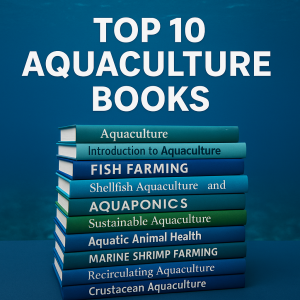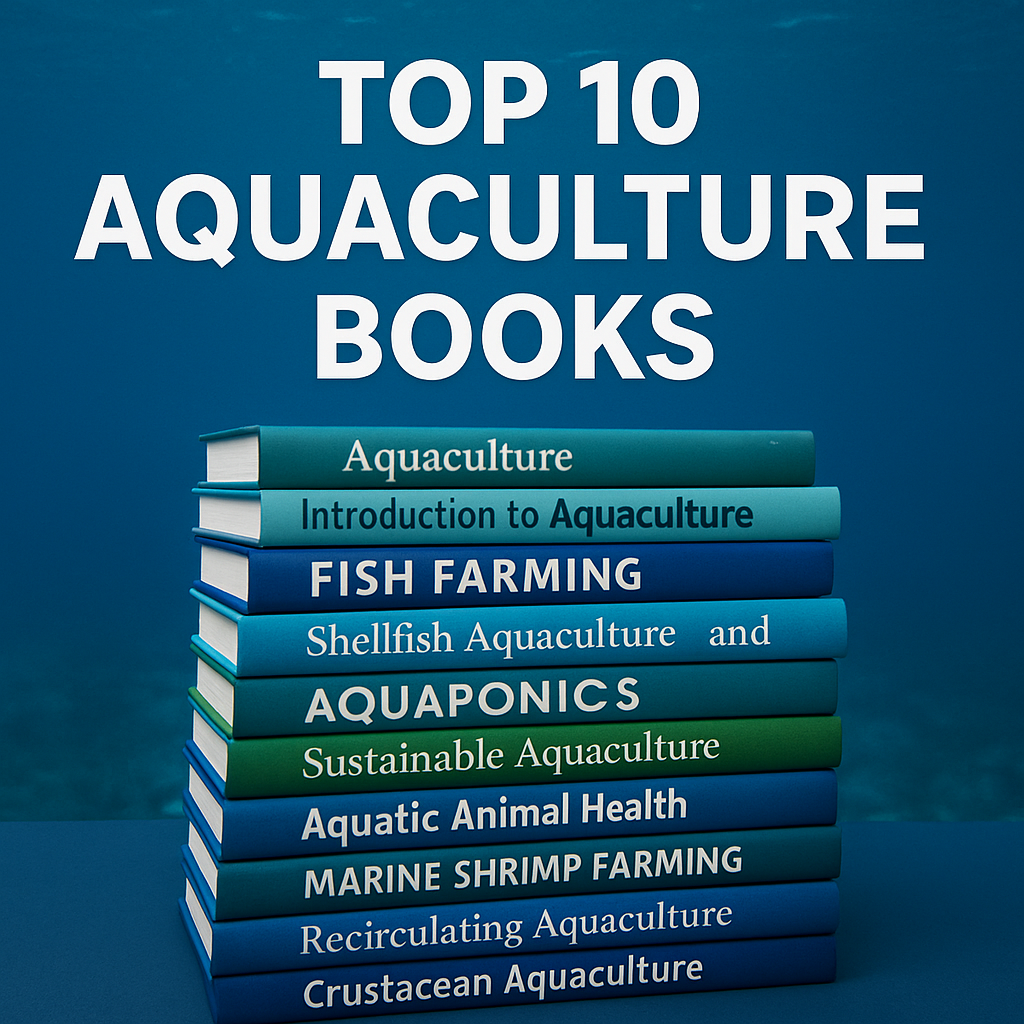Explore the top 10 aquaculture books every professional, student, or ocean enthusiast should read. From sustainable fish farming to marine biotechnology, dive into the essential literature shaping the future of aquaculture.

Why Aquaculture Matters in Modern Maritime Operations
Aquaculture—also known as fish farming—is no longer just a niche industry. It now supplies over 50% of the world’s seafood (FAO, 2024), and its role in global food security, maritime economies, and sustainable ocean management is growing rapidly. As wild fish stocks face pressure from overfishing and climate change, aquaculture offers a path forward—one that’s rich in innovation, science, and policy.
But aquaculture isn’t just about feeding the world. It also intersects with marine conservation, coastal livelihoods, maritime logistics, and environmental regulations. That’s why having the right knowledge is crucial—whether you’re a university student, a sustainability officer, a fisheries manager, or simply someone curious about where your seafood comes from.
In this guide, we spotlight ten of the best aquaculture books that combine real-world relevance, scientific depth, and accessibility for global readers. Let’s dive in.
1. Aquaculture: An Introductory Text
Author: Robert R. Stickney
Publisher: CABI
Edition: 3rd (2022)
This foundational textbook provides a clear, structured introduction to aquaculture systems, including freshwater, marine, and brackish environments. Stickney’s writing is readable yet scientific, making it perfect for both classroom use and self-study.
Why It’s Essential
Stickney bridges basic biology with engineering, feed technologies, and sustainability. He also includes recent discussions on climate impacts, antibiotic resistance, and offshore aquaculture innovations.
📘 Best for: Undergraduates, technical officers, and readers new to aquaculture.
2. Ecological Aquaculture: The Evolution of the Blue Revolution
Editor: Barry Costa-Pierce
Publisher: Blackwell Science
Published: 2020 (Updated Edition)
A thoughtful deep dive into ecosystem-based aquaculture. Costa-Pierce leads a multidisciplinary team that explores how aquaculture can be ecologically integrated rather than environmentally destructive.
Why It’s Special
Includes real-world case studies from Norway, Vietnam, and Canada, exploring community-based models, integrated multitrophic aquaculture (IMTA), and habitat restoration.
📘 Best for: Environmental scientists, policymakers, and aquaculture entrepreneurs.
3. Aquaculture Engineering
Authors: Odd-Ivar Lekang
Publisher: Wiley-Blackwell
Edition: 2nd (2022)
If you want a comprehensive technical guide to designing and managing aquaculture systems, this is the go-to text. It covers everything from recirculating aquaculture systems (RAS) to water quality management and structural design.
Highlight
Updated to include sensor networks, IoT in aquaculture, and real-time monitoring systems—important trends emphasized in reports by DNV and Inmarsat.
📘 Best for: Engineers, project managers, and marine technology students.
4. Fish Welfare
Editors: Edward J. Branson
Publisher: Wiley-Blackwell
Published: 2019
Aquaculture isn’t just about production numbers—it’s also about ethics. This book addresses stress, disease, humane slaughter, and welfare regulations.
Regulatory Insight
Explores EU Directive 2010/63/EU, OIE guidelines, and practices endorsed by Marine Stewardship Council (MSC) and Aquaculture Stewardship Council (ASC).
📘 Best for: Welfare officers, veterinarians, hatchery managers.
5. Offshore Aquaculture
Editor: José Aguilar-Manjarrez et al.
Publisher: FAO / World Bank
Published: 2021
This comprehensive report-turned-book offers data-rich analysis on offshore aquaculture zones, spatial planning, and policy frameworks for open-ocean farming.
Real-World Relevance
Analyzes projects in the Gulf of Mexico, Mediterranean Sea, and South China Sea. Includes marine spatial planning models aligned with UN Sustainable Development Goal 14.
📘 Best for: Coastal planners, NGOs, and maritime regulators.
6. Biotechnology and Genetics in Fisheries and Aquaculture
Authors: Andy Beaumont & Kate Hoare
Publisher: Wiley-Blackwell
Edition: 3rd (2022)
A deep dive into selective breeding, transgenic technologies, and disease resistance in aquaculture.
Cutting-Edge Material
Includes CRISPR, eDNA monitoring, and genetic traceability—practices that are transforming broodstock selection in commercial hatcheries.
📘 Best for: Aquaculture scientists, marine biologists, and research students.
7. Small-Scale Aquaculture
Author: Randall E. Brummett
Publisher: Practical Action Publishing
Published: 2021
Focused on low-income and rural aquaculture systems, especially in Sub-Saharan Africa and Southeast Asia.
Social Impact
Includes gender inclusion, microcredit for aquaculture, and circular aquaculture techniques using livestock waste integration.
📘 Best for: NGOs, community developers, and policymakers.
8. Aquaponics Food Production Systems
Editors: G. Junge, D. Goddek, R. Stoknes
Publisher: Springer
Published: 2020
Merging aquaculture with hydroponics, this book explains how to grow fish and vegetables together in closed-loop systems.
Sustainability Angle
Explores nutrient cycling, ammonia reduction, and energy efficiency—core principles endorsed by UNEP’s circular economy model.
📘 Best for: Urban farmers, green technology students, and sustainability educators.
9. The Economics of Aquaculture
Author: Carole R. Engle
Publisher: Wiley-Blackwell
Published: 2018
A rare and invaluable resource focused entirely on financial models, risk management, and marketing in aquaculture ventures.
Practical Use
Offers break-even analyses, ROI calculators, and global trade data from FAO and World Bank aquaculture statistics.
📘 Best for: Investors, aquaculture entrepreneurs, and policy analysts.
10. Aquaculture Toxicology
Author: Jorge M. L. Sousa
Publisher: Elsevier
Published: 2023
This newly released book focuses on chemical safety, microplastics, algal toxins, and contaminants in aquaculture systems.
Data-Driven Content
Includes toxicological thresholds from EFSA, NOAA, and ICES, with real-world case studies on antibiotic contamination in shrimp farming.
📘 Best for: Environmental toxicologists, quality control specialists, regulatory agencies.
Case Studies: Aquaculture Successes from Around the World
Norway
Norway is the global leader in salmon farming, using RAS and closed containment systems to reduce sea lice and escapees. Supported by DNV-certified biosecurity protocols.
Vietnam
Small-scale shrimp farms in Vietnam have adopted biofloc technology and solar-powered water systems to increase productivity while reducing chemical input.
Canada
British Columbia has introduced offshore aquaculture trials with AI-driven feed monitoring and remote surveillance, backed by funding from Canada’s Ocean Supercluster.
These real-world implementations echo the theories and systems detailed in the books above—highlighting how research turns into practice.
Frequently Asked Questions
What is aquaculture?
Aquaculture is the farming of aquatic species—like fish, crustaceans, and seaweed—in controlled environments for food, conservation, or industrial use.
Is aquaculture sustainable?
It can be. With proper regulation, eco-friendly technologies, and responsible feed sourcing, aquaculture can reduce pressure on wild fish stocks and protect marine ecosystems.
Which book is best for beginners?
Stickney’s Aquaculture: An Introductory Text is perfect for newcomers due to its clear explanations and broad coverage.
Are there books about small-scale or rural aquaculture?
Yes. Small-Scale Aquaculture by Brummett is an excellent resource, especially for community-driven or low-tech operations.
What is the role of biotechnology in aquaculture?
Biotechnology improves disease resistance, growth rates, and sustainability by using tools like genetic selection and molecular diagnostics.
Are these books suitable for international readers?
Yes. Most are written in clear, global English and include case studies from diverse regions.
Where can I access these books?
Most are available through university libraries, maritime academies, Amazon, or publisher websites such as Wiley, Springer, or FAO.
Conclusion: Building Knowledge for a Blue Economy
Aquaculture is not just about farming fish. It’s about feeding the future, protecting our oceans, and building sustainable livelihoods. These ten books provide the knowledge and inspiration needed to understand, innovate, and thrive in the dynamic world of aquaculture.
Whether you’re a student, policymaker, hatchery manager, or sustainability advocate, investing time in these resources is a smart move for your maritime journey.
👉 Call to Action:
Add one or more of these titles to your reading list or curriculum. The ocean is changing fast—make sure your knowledge stays ahead of the tide.
References
-
FAO. (2024). The State of World Fisheries and Aquaculture. https://www.fao.org
-
DNV. (2023). Aquaculture Systems Risk Assessment. https://www.dnv.com
-
Inmarsat. (2022). Connected Aquaculture White Paper. https://www.inmarsat.com
-
World Bank. (2023). Aquaculture for Food Security. https://www.worldbank.org
-
MSC. (2023). Certification and Standards for Sustainable Fishing. https://www.msc.org
-
Springer. (2020). Aquaponics Food Systems. https://link.springer.com
-
Elsevier. (2023). Aquaculture Toxicology. https://www.elsevier.com
-
CABI. (2022). Aquaculture: An Introductory Text. https://www.cabi.org

